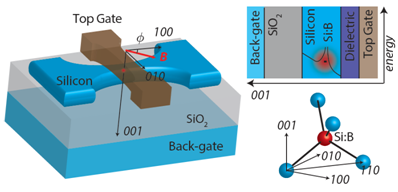Hole spin qubits in Si: coherence and control
- 来源:合肥微尺度物质科学国家研究中心
| 报告题目 | Hole spin qubits in Si: coherence and control |
| 报告人 | Dr. Dimitrie Culcer |
| 报告人单位 | The University of New South Wales, Australia |
| 报告时间 | 2019-05-09 16:00:00 |
| 报告地点 | 合肥微尺度物质科学国家研究中心九楼会议室(9004) |
| 主办单位 | 合肥微尺度物质科学国家研究中心、国际功能材料量子设计中心(ICQD) |
| 报告介绍 | Abstract: Electrical control of quantum bits could pave the way for scalable quantum computation. An acceptor spin qubit in Si, based on spin-3/2 holes, can be controlled by electrical means using a gate electrode, which offers fast one- and two-qubit rotations and long coherence times at certain sweet spots. The relaxation time T1, while allowing 105 operations, is the primary limiting factor [1]. I will show that, due to the interplay of the Td symmetry of the acceptor in the Si lattice and the spin-3/2 characteristic of hole systems, an applied in-plane magnetic field strongly enhances the performance and coherence properties of the qubit. An appropriate choice of magnetic field orientation leads to a near-total suppression of spin relaxation as well as full tunability of two-qubit operations in a parameter regime in which dephasing due to charge fluctuations can be eliminated. Interestingly for spintronic applications, we find an extreme in-plane anisotropy such that the in-plane g-factor can vanish under certain circumstances [2].
Fig. 1. Sketch of the device geometry and layered heterostructure in the (001) direction. The orientation of the magnetic field within the plane is given by ϕ, the angle with respect to the (100) direction. References [1] J. Salfi, J. A. Mol, D. Culcer, and S. Rogge, Physica Review Letters 116, 246801 (2016). [2] J. C. Abadillo-Uriel, J. Salfi, X. Hu, S. Rogge, M. J. Calderon, and D. Culcer, arXiv:1706.08858
Biosketch: Dimitrie Culcer obtained his PhD from the University of Texas at Austin in 2005. He worked as a postdoctoral research fellow first at Argonne National Laboratory between 2006-2008, and subsequently at the University of Maryland, College Park, 2008-2010. He became a faculty member at the University of Science and Technology of China in 2010, where he was a member of the International Center for Quantum Design of Functional Materials. In 2013 he moved to the University of New South Wales in Sydney where he is currently a Senior Lecturer. His research interests include quantum information and computation, spin-orbit coupling and topological effects in condensed matter physics, quantum transport theory and electron-electron interaction effects, in particular the interplay of interactions with strong spin-orbit coupling. He is actively working in all these areas. |
相关文章
- 电催化体系化学热力学2025-10-15 15:41:02
- Materials Innovation for Energy Storage and Conversion2025-10-14 09:39:06
- 非常规超导2025-10-02 08:46:30
- Epitaxial Large-gap topological insulator on semiconductor for seamless device integration2025-09-25 17:20:03
- Exciton and Charge-Carrier Dynamics in Organic and Inorganic Semiconductors Through Pump-Probe Spec...2025-09-25 14:12:32
- Non-equilibrium orbital dynamics in Bloch electron systems2025-09-25 14:10:02


